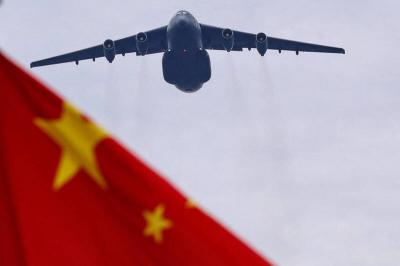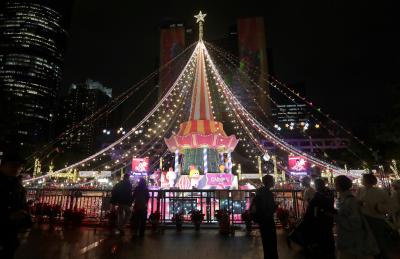China’s growing military strength, from stealth jets to aircraft carriers and anti-satellite missiles, has shifted the balance of power in the Taiwan Strait to Beijing’s advantage and this will not be materially affected by an imminent US arms deal with Taiwan.
The duration of any potential conflict between China and Taiwan will be a matter of days, not weeks or months, analysts and experts say.
US President Barack Obama’s administration is expected to formally notify the US Congress next week on an arms package including F-16 upgrades for Taiwan, but not the new fighters Taipei wants.
Beijing, meanwhile, has shown no sign of ending an arms build-up that is strategically focused on Taiwan, and analysts say the arms deal will do little to alter the balance.
China’s military advances have continued despite a warming of ties across the narrow Taiwan Strait that followed the election of President Ma Ying-jeou (馬英九) in 2008, and his signing of landmark trade and economic pacts.
Taiwan’s military can do little to disguise its unease.
“There have also been no signs of adjustments to military deployments facing our country,” Minister of National Defense Kao Hua-chu (高華柱) wrote in July in the foreword to the ministry’s annual White Paper.
“We must build forces that are as impregnable as a rock,” he said.
The US Department of Defense’s annual assessment to Congress last month warned that China “remains focused on developing the pre-requisite military capabilities to eventually settle the dispute on Beijing’s terms.”
Taiwan once held the military edge against a backward Chinese People’s Liberation Army (PLA). Today, experts generally agree that in the event of conflict, Taiwan would have at most only a few days to hold off China and get help from outside, most likely the US, if they were to stand any chance.
“No one’s really asking the question: Could Taiwan beat China in an all-out conflict?” said Matt Durnin, a researcher with the World Security Institute.
“The question they’re asking is whether or not Taiwan could survive long enough in a conflict [before] it would be able to recruit other countries to support it politically or militarily,” he said.
China has not compromised on its long-term demand that Taiwan is sovereign Chinese territory and must eventually come under its control.
Beijing’s military strategy, despite the warming of ties, remains focused on securing Taiwan, wrote security analyst Dean Cheng (成斌) of the Heritage Foundation in Washington.
“Coupled with limitations on US weapons sales, Taiwan is falling behind,” Cheng said. “Worse, the steady modernization of the PLA has not been matched by Taiwan.”
Taiwan in the past was able to rely on China’s inability to project power across the Strait, its own technological superiority and the help of the US armed forces in the event of conflict, who would easily outclass China.
“China’s increasingly modern weapons and platforms threaten to negate many of those factors upon which Taiwan has depended,” the Pentagon said, pointing to China’s rapidly modernizing navy and air force and new, formidable ballistic missiles.
Unlike China, Taiwan has no nuclear weapons, and only a small number of Patriot missiles to defend against any missile attack.
Meanwhile, China’s military spending spree continues. Beijing in March said it would boost defense spending by 12.7 percent this year to 600 billion yuan (US$94 billion), marking a return to double-digit growth.
China downplays its spending, saying it is upgrading its outmoded forces and that its plans do not pose a threat to any country. It also notes its defense budget is far lower than that of the US.
However, Chinese President Hu Jintao (胡錦濤) has made modernizing the navy a priority. China is upgrading its destroyers and frigates to provide capability to sail further and strike harder, and is developing fearsome anti-ship ballistic missiles to take out US carriers.
Last month, China’s first aircraft carrier made its maiden run.
Taiwan, which for years relied on better equipment and better training, has been hobbled by the refusal of any country aside from the US to sell it weapons, fearing an angry response from China. The advantages it once maintained in the air slipped away over the past decade as China modernized.
Despite Taiwan’s public calls for weaponry, defense spending has not kept pace. The NT$300 billion (US$10 billion) earmarked for this year is just 2.2 percent of GDP. Ma had promised in his 2008 election campaign to raise that to 3 percent.
The aging of Taiwan’s fleet of fighters came into stark focus last week with the crash of two US-built F-5 aircraft, which it first put into service in the 1970s and still uses for training and reconnaissance missions.
The backbone of Taiwan’s air force is made up of about 140 US-made F-16A/Bs, about 60 French-built Mirage 2000s and about 130 Ching-kuo Indigenous Defense Fighters. Jets lost in accidents over the years are nearly impossible to replace.

Beijing could eventually see a full amphibious invasion of Taiwan as the only "prudent" way to bring about unification, the US Department of Defense said in a newly released annual report to Congress. The Pentagon's "Annual Report to Congress: Military and Security Developments Involving the People's Republic of China 2025," was in many ways similar to last year’s report but reorganized the analysis of the options China has to take over Taiwan. Generally, according to the report, Chinese leaders view the People's Liberation Army's (PLA) capabilities for a Taiwan campaign as improving, but they remain uncertain about its readiness to successfully seize

Taiwan is getting a day off on Christmas for the first time in 25 years. The change comes after opposition parties passed a law earlier this year to add or restore five public holidays, including Constitution Day, which falls on today, Dec. 25. The day marks the 1947 adoption of the constitution of the Republic of China, as the government in Taipei is formally known. Back then the Chinese Nationalist Party (KMT) governed China from Nanjing. When the KMT, now an opposition party in Taiwan, passed the legislation on holidays, it said that they would help “commemorate the history of national development.” That

Taiwan has overtaken South Korea this year in per capita income for the first time in 23 years, IMF data showed. Per capita income is a nation’s GDP divided by the total population, used to compare average wealth levels across countries. Taiwan also beat Japan this year on per capita income, after surpassing it for the first time last year, US magazine Newsweek reported yesterday. Across Asia, Taiwan ranked fourth for per capita income at US$37,827 this year due to sustained economic growth, the report said. In the top three spots were Singapore, Macau and Hong Kong, it said. South

Snow fell on Yushan (Jade Mountain, 玉山) yesterday morning as a continental cold air mass sent temperatures below freezing on Taiwan’s tallest peak, the Central Weather Administration (CWA) said. Snowflakes were seen on Yushan’s north peak from 6:28am to 6:38am, but they did not fully cover the ground and no accumulation was recorded, the CWA said. As of 7:42am, the lowest temperature recorded across Taiwan was minus-5.5°C at Yushan’s Fengkou observatory and minus-4.7°C at the Yushan observatory, CWA data showed. On Hehuanshan (合歡山) in Nantou County, a low of 1.3°C was recorded at 6:39pm, when ice pellets fell at Songsyue Lodge (松雪樓), a